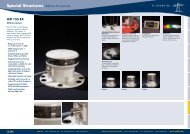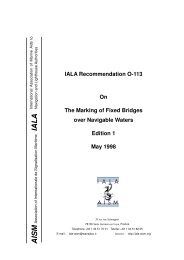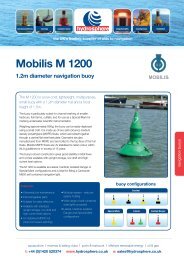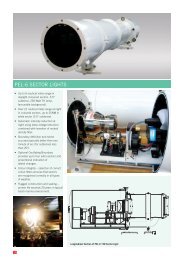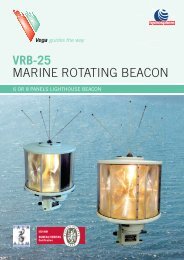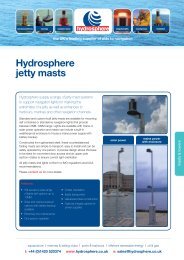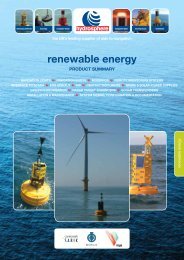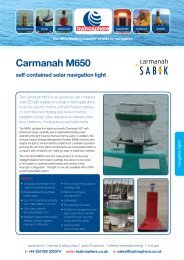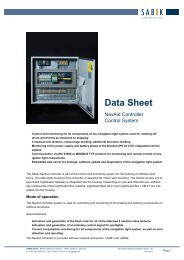Hydrosphere UK Ltd Complete Products & Services Catalogue
Hydrosphere UK Ltd Complete Products & Services Catalogue
Hydrosphere UK Ltd Complete Products & Services Catalogue
You also want an ePaper? Increase the reach of your titles
YUMPU automatically turns print PDFs into web optimized ePapers that Google loves.
The effective intensity of a lamp fl ashed<br />
by switching on and off, with an onperiod<br />
of T secs duration, is proportional<br />
to T/(T+0.2). If the range is barely<br />
adequate then long on-times should be<br />
used. See Figure 5.<br />
Lamp Life and Voltage Control<br />
Virtually all PEL Sector Lights are<br />
powered by batteries, and this is the<br />
recommended approach. Batteries can<br />
be charged by mains charger, or by solar<br />
panels. The voltage from the batteries<br />
will frequently exceed the rated voltage<br />
of the lamp. Applying such a voltage<br />
signifi cantly reduces lamp life from their<br />
rated 2000 hours.<br />
To prevent inadvertent lamp life<br />
reduction the CALC controller used on<br />
all PEL Sector Lights applies pulse-width<br />
modulation to lamp power, reducing the<br />
DC-rms power as necessary to ensure<br />
that the rated power of the lamp is never<br />
exceeded. When pulse-width modulation<br />
is active, the voltage measured at the<br />
lamp by a multi-meter will not be an<br />
accurate representation of the rms<br />
voltage. Meters measuring AC-rms<br />
voltage are not effective – an oscilloscope<br />
must be used to obtain an accurate<br />
reading.<br />
Power Supplies<br />
Voltage Spikes<br />
Mains-powered battery chargers and<br />
other mains-driven power supplies must<br />
be free of voltage spikes. Power supplies<br />
with high internal inductance present a<br />
problem when used to drive low-voltage<br />
lighted aids to navigation.<br />
When a lamp fails at the end of its life,<br />
this will often occur during the current<br />
inrush at startup. The sudden drop in<br />
current from a very high value (150<br />
Amps) to zero can induce large transient<br />
voltages (100-200 Volts) if there is any<br />
inductance in the supply circuit. This<br />
will damage controllers which are only<br />
designed to withstand voltages of<br />
the order of 40 Volts.<br />
Inductive Elements<br />
Older power supplies were built with<br />
inductive elements (chokes) which<br />
worked in conjunction with a capacitive<br />
element to smooth the pulsed DC after<br />
rectifi cation. These inductors store<br />
a large amount of energy in normal<br />
operation, and this energy generates the<br />
damaging voltage spikes.<br />
Battery Protection<br />
When initially installed and connected<br />
to a continuous battery charger, new<br />
batteries may have suffi cient capacity<br />
to absorb spikes, and they do not reach<br />
the Sector Light electronics. However,<br />
as batteries deteriorate over time this<br />
capability reduces, and spike damage to<br />
electronic equipment may start occurring.<br />
SMR Power Supplies Only<br />
Power supplies with high internal<br />
inductance are not suitable for use with<br />
neither PEL Sector Lights nor other lowvoltage<br />
lights. Switch-mode regulated<br />
battery chargers of good quality are<br />
recommended. Use the Vega VPR-39<br />
weatherproof switch-mode power supply<br />
if in doubt.<br />
Achieving Maximum Service Life<br />
Life Expectancy<br />
Many PEL Sector Lights around the<br />
world have been in service for more than<br />
20 years. Vega routinely refurbishes<br />
PEL Sector Lights back to new condition,<br />
which includes repolishing and recoating<br />
the optics, upgrading the electronics and<br />
repainting the exterior, for a fraction of<br />
the cost of a new light.<br />
Protection Against Moisture Ingress<br />
Users can enhance the life and<br />
performance of PEL Sector Lights by<br />
preventing ingress of moisture. This<br />
occurs whenever the light is opened for<br />
servicing, as it is otherwise completely<br />
sealed (each light holds 4 psi without<br />
leakage as a factory test).<br />
For longevity each light is best installed<br />
within a shelter, with just the barrel<br />
protruding. This reduces temperature<br />
changes imposed on the light from<br />
outside, and reduces bird fouling.<br />
Packs of properly-dried silica gel should<br />
always be left in the lampchanger area of<br />
each light between servicing, to absorb<br />
moisture introduced with each opening.<br />
Internal inspections should be no more<br />
frequent than six monthly, with twelve<br />
months being the normal.<br />
Routine Servicing<br />
Ensure lights are properly resealed after<br />
closing. Always inspect the condition<br />
and cleanliness of the O-ring seal and<br />
mating surface.<br />
Choosing a Sector Light<br />
Choice of Different Sizes<br />
Each marine port and harbour is unique,<br />
so a fl exible system is required. The<br />
PEL Light offers a range of subtenses<br />
and intensities to accommodate the<br />
constraints of each site. PEL Sector<br />
Lights make very effi cient use of solar<br />
power on remote sites.<br />
When a signal is required both day and<br />
night it is convenient if a single light can<br />
perform both functions. A light needs to<br />
be up to 5,000 times more intense<br />
during the day compared to night. The<br />
PEL-6 Sector Light has been designed for<br />
day & night operation.<br />
Two Models: PEL-3 and PEL-6<br />
There are two models of PEL Sector<br />
Light, PEL-3 and the PEL-6. Both<br />
are available in a range of standard<br />
subtenses, from 3.5° to 20°. The PEL-3<br />
is designed for night use, and uses lamps<br />
up to 100 Watts. Small prefocused lamps<br />
down to 10 Watts can be used where less<br />
intensity is acceptable and limited energy<br />
is available. The PEL-6 has much larger<br />
optics and is designed to meet the need<br />
for a day & night sector light. It carries<br />
a 250 Watt lamp, and automatically<br />
reduces intensity at night by two methods<br />
used together: night fi lter insertion and<br />
lamp voltage reduction.<br />
Balancing Intensity Against Subtense<br />
For a given lamp size in a PEL Sector<br />
Light, the wider the beam the less the<br />
intensity. An increase in horizontal<br />
subtense also gives an increase in<br />
vertical divergence, because the optics<br />
are circular (except with anamorphic<br />
models). Doubling the subtense will<br />
drop intensity to one-quarter (following<br />
the inverse-square law). The narrowest<br />
subtense that will meet the requirement<br />
should be used. If greater subtense or<br />
intensity is required, consider multiple<br />
lights or special anamorphic versions<br />
which spread light horizontally but<br />
keep the same vertical divergence.<br />
Choosing Individual Sector Angles<br />
For a leading line, one approach is to<br />
select a control point, like a harbour<br />
entrance. Consider the widest vessel<br />
passing the control point, and decide the<br />
width (in metres) of each sector at that<br />
point. The central white sector should<br />
be quite narrow – it is not marking the<br />
edges, but an acceptable deviation from<br />
the centre line before a colour change<br />
is seen. Use the tangent function to<br />
calculate individual sector angles.<br />
Night Intensity Reduction (Day & Night<br />
Lights) With all PEL Sector Lights,<br />
there are 6 options for lamp voltage at<br />
night, given that voltage during the day<br />
is 100%:<br />
5



